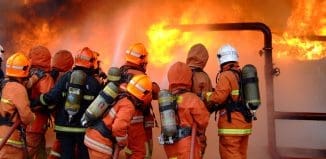Preparedness and Response to a Mass Casualty Terrorist Event
This post is also available in:  עברית (Hebrew)
עברית (Hebrew)
 Explosive devices are the most common weapons used by terrorists. The damage inflicted in recent events in India, Pakistan, Spain, Israel, and the United Kingdom demonstrate the impact of detonating explosives in densely populated civilian areas. Explosions can produce instantaneous havoc, resulting in numerous patients with complex, technically challenging injuries not commonly seen after natural disasters. Because many patients self-evacuate after a terrorist attack, pre-hospital care may be difficult to coordinate and hospitals near the scene can expect to receive a large influx, or surge, of patients after a terrorist strike.
Explosive devices are the most common weapons used by terrorists. The damage inflicted in recent events in India, Pakistan, Spain, Israel, and the United Kingdom demonstrate the impact of detonating explosives in densely populated civilian areas. Explosions can produce instantaneous havoc, resulting in numerous patients with complex, technically challenging injuries not commonly seen after natural disasters. Because many patients self-evacuate after a terrorist attack, pre-hospital care may be difficult to coordinate and hospitals near the scene can expect to receive a large influx, or surge, of patients after a terrorist strike.
The threat of terrorism exists at a time when hospitals in the United States are already struggling to care for patients who present during routine operations each day. Hospitals and emergency health care systems are stressed and face enormous challenges. With the occurrence of a mass casualty event (MCE), health systems would be expected to confront these issues in organization and leadership, personnel, infrastructure and capacity, communication, triage and transportation, logistics, and legal and ethical challenges.
The purpose of this interim guidance is to provide information and insight to assist public policy and health system leaders in preparing for and responding to an MCE caused by terrorist use of explosives (TUE). This document provides practical information to promote comprehensive mass casualty care in the event of a TUE event and focuses on two areas:
1. Leadership in preparing for and responding to a TUE event, and
2. Effective care of patients in the prehospital and hospital environments during a TUE event.
 This guidance recognizes the critical role that strategic leadership can have on the success or failure of preparing for and responding to a terrorist bombing. It outlines important leadership strategies for successfully preparing for and managing a TUE mass casualty event, including the concept of meta-leadership. Effective meta-leaders employ influence over authority and activate change above and beyond established lines of their decision-making and control. They are driven by a purpose broader than that prescribed by their formal roles. Therefore, they are motivated and act in ways that transcend the usual organizational confines, enabling them to successfully confront challenges and barriers in communication, organization and response, standards of care, and surge capacity.
This guidance recognizes the critical role that strategic leadership can have on the success or failure of preparing for and responding to a terrorist bombing. It outlines important leadership strategies for successfully preparing for and managing a TUE mass casualty event, including the concept of meta-leadership. Effective meta-leaders employ influence over authority and activate change above and beyond established lines of their decision-making and control. They are driven by a purpose broader than that prescribed by their formal roles. Therefore, they are motivated and act in ways that transcend the usual organizational confines, enabling them to successfully confront challenges and barriers in communication, organization and response, standards of care, and surge capacity.
The successful medical response to an MCE depends on effectively coordinating three critical areas of patient care: 1) pre-hospital care, 2) casualty distribution, and 3) hospital care. Critical steps must be taken throughout the response to ensure rapid and efficient patient triage, effective and appropriate distribution of patients to available hospitals and health care facilities, and proper management of the surge of patients at receiving hospitals.
Authors: Isaac Ashkenazi, MD, MPA, MSC, MNS, Richard C. Hunt, MD, FACEP, Scott M. Sasser, MD, FACEP, Sridhar V. Basavaraju, MD, Ernest E. Sullivent, MD, MPH, FACEP, Vikas Kapil, DO, MPH, FACOEM, Lisa C. McGuire, PhD, Lisa T. Garbarino, and Paula S. Peters, MPH, CHES
For the full article, use the following URL:
www.emergency.cdc.gov/masscasualties





























